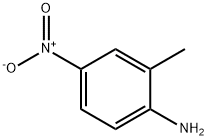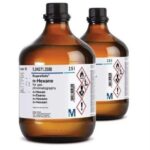| 2-Methyl-4-nitroaniline Basic information |
| Description Reference |
| Product Name: | 2-Methyl-4-nitroaniline |
| Synonyms: | RedbaseRL;Sanyo Fast Red RL Base;Sanyo Fast Red Salt RL;sanyofastredrlbase;sanyofastredsaltrl;Spectrolene Red RL;spectroleneredrl;Symulon Red RL Base |
| CAS: | 99-52-5 |
| MF: | C7H8N2O2 |
| MW: | 152.15 |
| EINECS: | 202-762-1 |
| Product Categories: | Amines;Aromatics;Miscellaneous Reagents;Organic Nonlinear Optical Materials;Functional Materials;Intermediates of Dyes and Pigments;Aromatic Hydrocarbons (substituted) & Derivatives;bc0001 |
| Mol File: | 99-52-5.mol |
 |
| 2-Methyl-4-nitroaniline Chemical Properties |
| Melting point | 130-132 °C(lit.) |
| Boiling point | 294.61°C (rough estimate) |
| density | 1.1586 |
| vapor pressure | 20.4hPa at 133.5℃ |
| refractive index | 1.6276 (estimate) |
| Fp | 157.2℃ |
| storage temp. | Store below +30°C. |
| solubility | Dichloromethane, DMSO, Ethyl Acetate, Methanol |
| pka | 0.92±0.10(Predicted) |
| Colour Index | 37100 |
| form | Crystalline Powder or Fine Needles |
| color | Yellow to khaki or brownish |
| PH | 7 (H2O)(aqueous suspension) |
| Water Solubility | <0.1 g/100 mL at 22 ºC |
| BRN | 775772 |
| LogP | 1.311 at 25℃ |
| CAS DataBase Reference | 99-52-5(CAS DataBase Reference) |
| NIST Chemistry Reference | 5-Nitro-2-aminotoluene(99-52-5) |
| EPA Substance Registry System | 2-Methyl-4-nitroaniline (99-52-5) |
| Safety Information |
| Hazard Codes | T,N,Xi |
| Risk Statements | 23/24/25-33-51/53 |
| Safety Statements | 28-36/37-45-61-28A |
| RIDADR | UN 2660 6.1/PG 3 |
| WGK Germany | 2 |
| RTECS | XU8210000 |
| Hazard Note | Irritant |
| TSCA | Yes |
| HazardClass | 6.1 |
| PackingGroup | III |
| HS Code | 29214300 |
| Provider | Language |
|---|---|
| 2-Amino-5-nitrotoluene | English |
| SigmaAldrich | English |
| ACROS | English |
| ALFA | English |
| 2-Methyl-4-nitroaniline Usage And Synthesis |
| Description | 2-Methyl-4-nitroaniline was used in preparing in-plane aligned nanofibers by the electrospinning technique. It was the starting reagent in the synthesis of 3-chloro-5-methylphenyl isocyanate. It was used to deposit polycrystalline thin films on Ag, Cu and Si by conventional and partially ionized beam deposition. |
| Reference | 2. Seo, Kang, and C. Bonner. “Growth of organic thin films on Si (100) surfaces: 2-Methyl-4-Nitroaniline (MNA).” APS Southeastern Section Meeting APS Southeastern Section Meeting Abstracts, 2002. |
| Chemical Properties | Yellowneedle |
| Uses | 2-Methyl-4-nitroaniline was used in preparing in-plane aligned nanofibers by the electrospinning technique. It was the starting reagent in the synthesis of 3-chloro-5-methylphenyl isocyanate. It was used to deposit polycrystalline thin films on Ag, Cu and Si by conventional and partially ionized beam deposition. |
| Uses | A red azoic dye. |
| General Description | Yellow needles or mustard yellow powder. |
| Air & Water Reactions | Insoluble in water. |
| Reactivity Profile | 2-Methyl-4-nitroaniline is incompatible with acids, acid chlorides, acid anhydrides, chloroformates and strong oxidizing agents. |
| Fire Hazard | Flash point data for 2-Methyl-4-nitroaniline are not available; however, 2-Methyl-4-nitroaniline is probably combustible. |
| Purification Methods | Crystallise the nitrotoluidine from EtOH. The acetyl and benzoyl derivatives have m 200o and 174o (EtOH) respectively. [Beilstein 12 IV 1809.] |
| 2-Methyl-4-nitroaniline Preparation Products And Raw materials |








